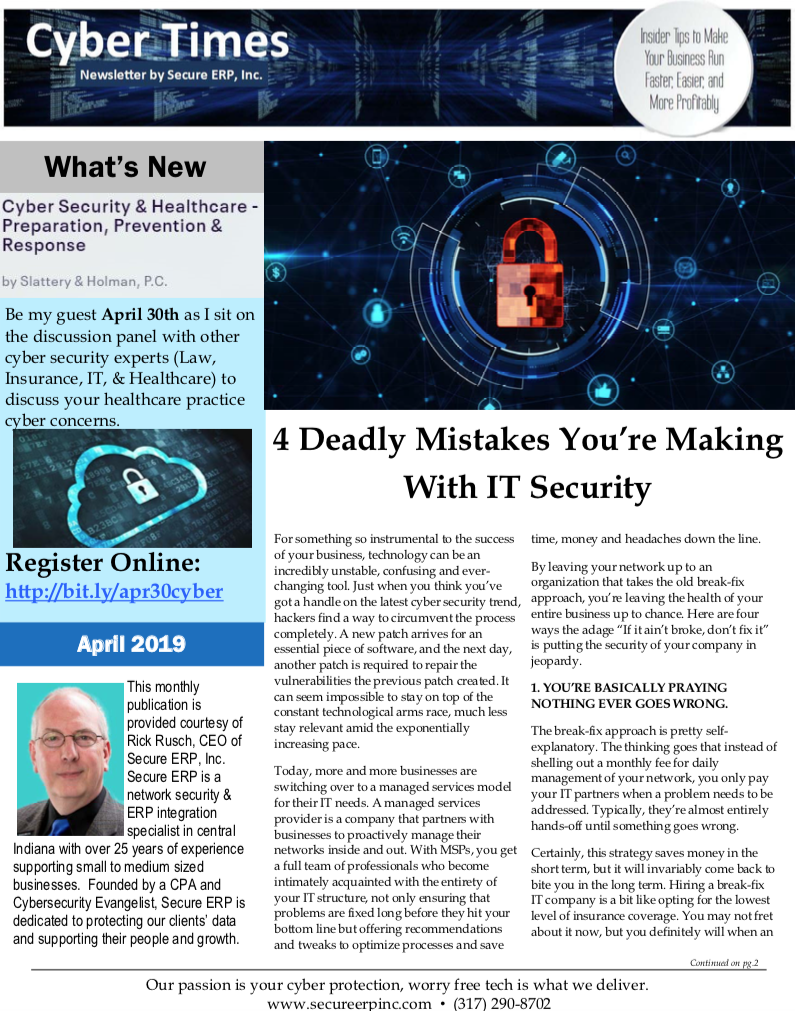
 Cyber Security & Healthcare - Preparation, Prevention & Response
Cyber Security & Healthcare - Preparation, Prevention & Response
by Slattery & Holman, P.C.
April 30th
Register Online:
4 Deadly Mistakes You’re Making
With IT Security
 For something so instrumental to the success of your business, technology can be an incredibly unstable, confusing and ever-changing tool. Just when you think you’ve got a handle on the latest cyber security trend, hackers find a way to circumvent the process completely. A new patch arrives for an essential piece of software, and the next day, another patch is required to repair the vulnerabilities the previous patch created. It can seem impossible to stay on top of the constant technological arms race, much less stay relevant amid the exponentially increasing pace.
For something so instrumental to the success of your business, technology can be an incredibly unstable, confusing and ever-changing tool. Just when you think you’ve got a handle on the latest cyber security trend, hackers find a way to circumvent the process completely. A new patch arrives for an essential piece of software, and the next day, another patch is required to repair the vulnerabilities the previous patch created. It can seem impossible to stay on top of the constant technological arms race, much less stay relevant amid the exponentially increasing pace.
Today, more and more businesses are switching over to a managed services model for their IT needs. A managed services provider is a company that partners with businesses to proactively manage their networks inside and out. With MSPs, you get a full team of professionals who become intimately acquainted with the entirety of your IT structure, not only ensuring that problems are fixed long before they hit your bottom line but offering recommendations and tweaks to optimize processes and save time, money and headaches down the line.
By leaving your network up to an organization that takes the old break-fix approach, you’re leaving the health of your entire business up to chance. Here are four ways the adage “If it ain’t broke, don’t fix it” is putting the security of your company in jeopardy.
- YOU’RE BASICALLY PRAYING NOTHING EVER GOES WRONG.
The break-fix approach is pretty self-explanatory. The thinking goes that instead of shelling out a monthly fee for daily management of your network, you only pay your IT partners when a problem needs to be addressed. Typically, they’re almost entirely hands-off until something goes wrong.
Certainly, this strategy saves money in the short term, but it will invariably come back to bite you in the long term. Hiring a break-fix IT company is a bit like opting for the lowest level of insurance coverage. You may not fret about it now, but you definitely will when an accident happens and you’re forced to pour thousands of dollars into repairs. And sadly, the threat of your business being hacked is actually greater than the chances you’ll be in a serious car accident!
- YOU’RE LEAVING HOLES IN YOUR DEFENSES.
Today’s tech world is a constant game of whack-a-mole, with security experts frantically hammering down on every digital threat that rears its ugly head. For the entirety of your security structure to be equipped with the latest and greatest, it takes a team of genuine experts keeping an eye on your systems and ensuring everything is up to snuff.
With a break-fix approach, it’s likely you don’t detect flaws in your system until long after they’ve already been exploited, costing you dearly. And it’s important to remember that every data breach has the potential to be utterly catastrophic, doing so much damage that it can close down your business for good. Better to stay one step ahead with an MSP by your side.
- YOU’RE OPENING YOURSELF UP TO COSTLY SERVER DOWNTIME.
When the very survival of your business depends upon staying online and serving your customers, every minute your network is down – your assets are locked down behind ransomware or your tech is fried to the point that you’re at a standstill – is a minute that you cannot afford. According to Gartner, the average cost of IT downtime is a whopping $5,600 per minute, and that doesn’t even factor in disgruntled clients or missed communications.
The top priority of your IT infrastructure should be to prevent downtime from ever occurring, not to minimize the amount of downtime you suffer when something goes wrong.
- YOU AREN’T OPERATING AT PEAK EFFICIENCY.
One of the most insidious costs of the break-fix approach doesn’t have anything to do with your network breaking down. It chips away at your bottom line gradually and silently, without causing much of a fuss.
Without a proactive eye on your systems, chances are you aren’t implementing the processes and software that keep everything working at its highest potential. You’ll be using clunky workarounds to simple problems without even realizing you’re doing it. The seconds you waste on Internet bottlenecks will add up over time, especially when multiplied by your entire company.
The fact is, the break-fix model of doing business is, ironically, broken. Consider partnering with an MSP and invest in the long-term future of your company.
Cyber Threats & Solutions Webinar Series
April 18 @ 1pm EDT—The Travel Edition

When you're traveling you're at greater cyber risk than in the office.
Who Should Attend?
C-Level executives & managers who are concerned about lost or stolen devices; privacy of confidential information; employment litigation introduced when employees use personal devices to access company data; and reputational damage along with State & Federal laws that carry heavy fines for lost or stolen customer/employee data. Of particular importance for those organizations that handle ANY sensitive data, medical records (or serve clients who have such records) or that want to avoid having their bank account wiped out due to a cyber-attack or ransomware.
Register online: https://www.secureerpinc.com/apr18web
or call our office at (317) 290-8702.
Cyber Security TIPs
Biometrics Silver Security Bullet?
You see it in articles, hear it from security experts and it’s replete in movies now, if you want top security, forget passwords and use your body. Fingerprint, face or eye, these are the ultimate weapons to defeat hackers. WRONG!
How are all these identifiers stored in the digital world? In the same format as a password. Are these credentials stolen? Absolutely!
Once stolen, how exactly do you change your fingerprint information to prevent a hacker from using it against you? This is the primary reason I won’t use biometrics anywhere if given a choice. As a side note, I don’t give my DNA to any service either as they give it to the government as you unwittingly gave them consent when you signed up.
In 2015, foreign hackers breached the United Stated Office of Personnel Management (OPM) and made off with troves of data, including 5.6 million sets of fingerprints from US intelligence agents and other government employees. Use a password manager with 2FA instead and you’ll be using TOP security. -R2
Great CEOs Give Their
Teams Freedom To Choose

Something surprised me the other day. A colleague, who had (sniff!) previously left to work for a big company, told me the reason she’d returned to my company, ghSMART. She’d left a couple of years ago to become a senior executive at a top-tier fashion company. It sounded like a dream job at the time, but within two years, she came back to our firm.
I was happy she’d returned, but it was a mystery to me why she’d decided to come back. When I asked her while sitting next to her at our firm’s annual summit, she paused for a second. “The real reason is our culture of freedom here at ghSMART,” she said. “It’s not like that in Corporate-land. There was no freedom there. Meetings, meetings, meetings. And if anybody above me, or below me, called a meeting, I had to be there, as their culture requires. It’s like nobody trusted anybody to think or act on their own! Everything was by committee. Drove me nuts. Here, we’re way more empowered to make decisions, to use our talents, to team up with colleagues when it makes sense and to take initiative and make things happen for our clients.”
Her story made me feel good. As chairman and founder of ghSMART, one of my two big goals for starting our company was to provide a career “home” to exceptionally talented people. At one point, I had to make a key decision about our culture. I had to pick between hiring not-so-smart people and boxing them in with excessive meetings, processes and bureaucracy to limit their ability to do damage; or to hire smart people, as in ridiculously smart and capable people, and give them the freedom to make choices.
In the end, I chose the path of “talent and freedom,” of course. It just made a lot more sense to me. I worked to create a culture in which my team had the freedom to choose which clients to serve; which types of problems to help them solve and how to go about doing that; to choose their own career path at the firm; and to choose which colleagues to work with along the way.
This decision wasn’t original though. It came from watching some of the best CEOs in the world hire the most skilled folks in business and learning about the results those employees produced when they were given an unusual amount of freedom to make decisions. It became clear to me over the years that the mark of a truly great CEO is the ability to hire super-talented people and give them the opportunity to forge their own path. The best leaders are able to attract the best talent and give their colleagues the choice to make life-and-death decisions swiftly and effectively.
 Geoff Smart is chairman and founder of ghSMART. Geoff is co-author, with his colleague Randy Street, of the New York Times best-selling book, Who: A Method For Hiring, and the author of the #1 Wall Street Journal best seller, Leadocracy: Hiring More Great Leaders (Like You) Into Government. Geoff co-created the Topgrading brand of talent management. He is the founder of two 501(c)(3) nonprofit organizations. SMARTKids Leadership
Geoff Smart is chairman and founder of ghSMART. Geoff is co-author, with his colleague Randy Street, of the New York Times best-selling book, Who: A Method For Hiring, and the author of the #1 Wall Street Journal best seller, Leadocracy: Hiring More Great Leaders (Like You) Into Government. Geoff co-created the Topgrading brand of talent management. He is the founder of two 501(c)(3) nonprofit organizations. SMARTKids Leadership
Program™ provides 10 years of leadership tutoring and the Leaders Initiative™ seeks to deploy society’s greatest leaders into government. Geoff earned a BA in economics with honors from Northwestern University, and an MA and Ph. D in psychology from Claremont Graduate University.
Top Tips To Prevent Cybercriminals From Hacking Your Network
- PLAN FOR THE WORST. Though it’s vital to invest in prevention, you shouldn’t focus all your efforts on preventing an attack, because one might occur despite your preparations. Be braced to respond to an incident with a detailed plan.
- EDUCATE YOUR TEAM. According to the Ponemon Institute, only half of companies surveyed felt that current employee training adequately reduced noncompliant security behaviors. Most cyberbreaches originate from a simple mistake, so training your team is an essential early step.
- MAKE A BUDGET THAT REFLECTS YOUR PRIORITIES. Best practices are easy to preach at the beginning, but in order to keep strengthening your barriers and staying abreast of cyber security trends, you need to build regular cyber security actions into your yearlong plans. This means that security should be a permanent, substantial item in any budget you develop. SmallBizTrends.com, 11/20/2018
HOW TO SELL TO FEWER PEOPLE AND INCREASE YOUR SALES
According to Bruce Eckfeldt, business coach for Gazelles, most businesses with $1 million to $10 million revenues tend to use “chameleon selling” as their prime tactic. They hunt down leads and tailor their products and services to the needs of the prospect. But while this is a decent model for a new business, it isn’t actually scalable.
Businesses that scale hone in on a limited series of products and services that pinpoint the needs of a target set of customers. That’s why it’s so important that you should start by defining your ideal customer – what car they drive, what school they go to, how big their business is, what their industry is and where they are located. You even need to know what’s going on in their head: their values, concerns, priorities, tendencies and habits. Finally, you can determine what prompted a sale or triggered one of your core customers’ initial engagements with your company, allowing you to be more strategic and specific with your sales processes. Inc.com, 12/20/18
PILOTLESS PLANES ARE ON THEIR WAY — BUT WOULD YOU EVER FLY IN ONE?
Last January, Airbus CTO Grazia Vittadini stated the company is hopeful that, soon, advancements in artificial intelligence will allow for autonomous planes to take to the skies. This would mean lower pilot costs, fewer pilot shortages and, eventually, cheaper flights for consumers. The question is, can airlines persuade passengers to get in a sealed sky-tube six miles in the air piloted by a machine? Maybe after cargo planes start to go autonomous, we’ll be convinced, but for now, that prospect seems more than a little iffy.
DigitalTrends.com, 1/20/2019


 Contact Us At
Contact Us At


